Leadership and Responsible Leadership in a Changing World Report
VerifiedAdded on 2023/01/13
|9
|2592
|39
Report
AI Summary
This report, prepared for a Leadership Theory and Practice module, delves into the evolving perspectives of leadership across economic, social, and political landscapes. It assesses the challenges faced by leaders in today's volatile business environment, including managerial effectiveness, employee development, and stakeholder management. The report then clarifies the characteristics of responsible leadership, emphasizing ethical standards, stakeholder interests, and accountability. Furthermore, it analyzes the importance of demonstrating responsible leadership during organizational change, highlighting factors such as leadership alignment, emotional connection, and trust-building. The analysis draws on various sources and provides a comprehensive overview of leadership principles and practices, suitable for business management students.
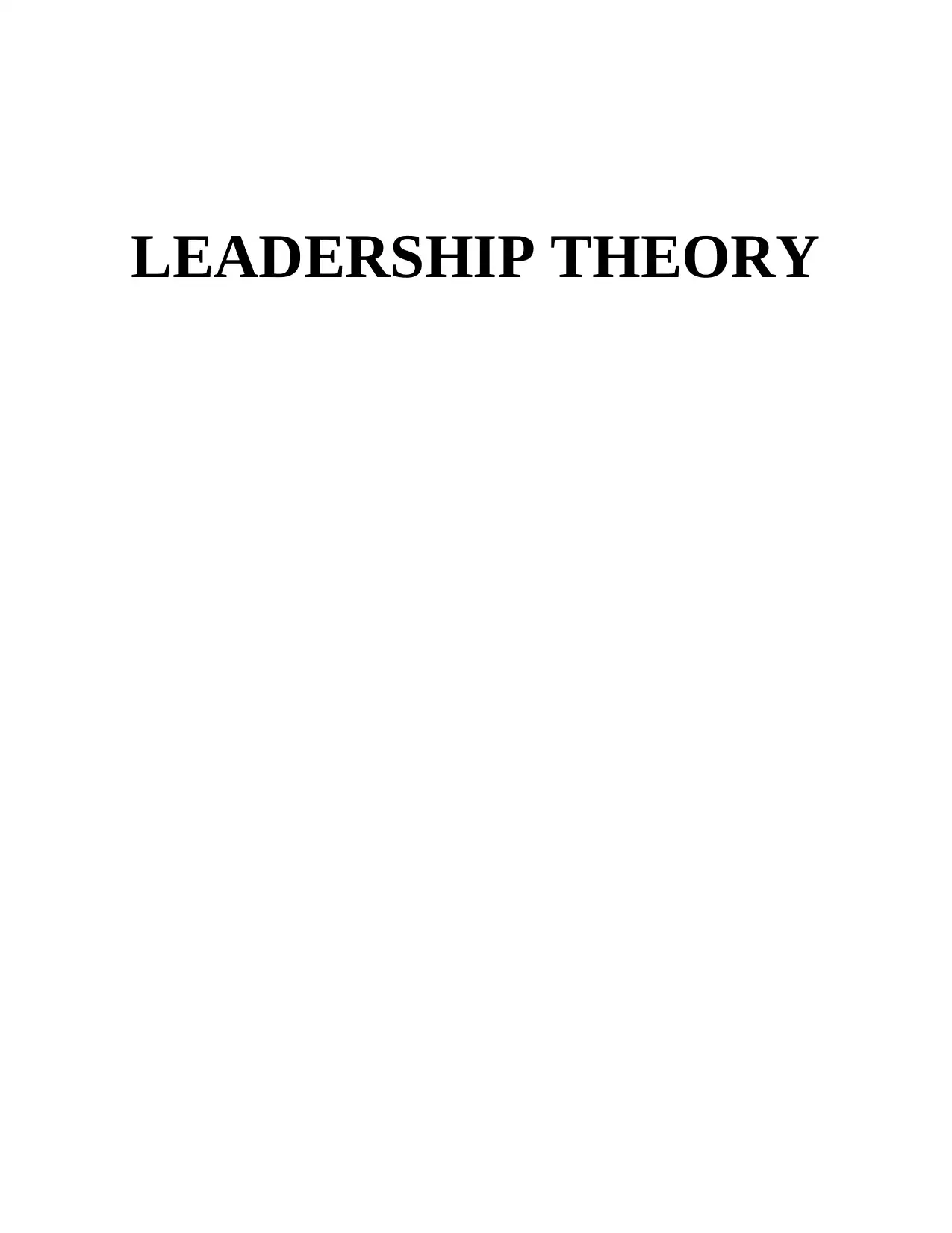
LEADERSHIP THEORY
Paraphrase This Document
Need a fresh take? Get an instant paraphrase of this document with our AI Paraphraser
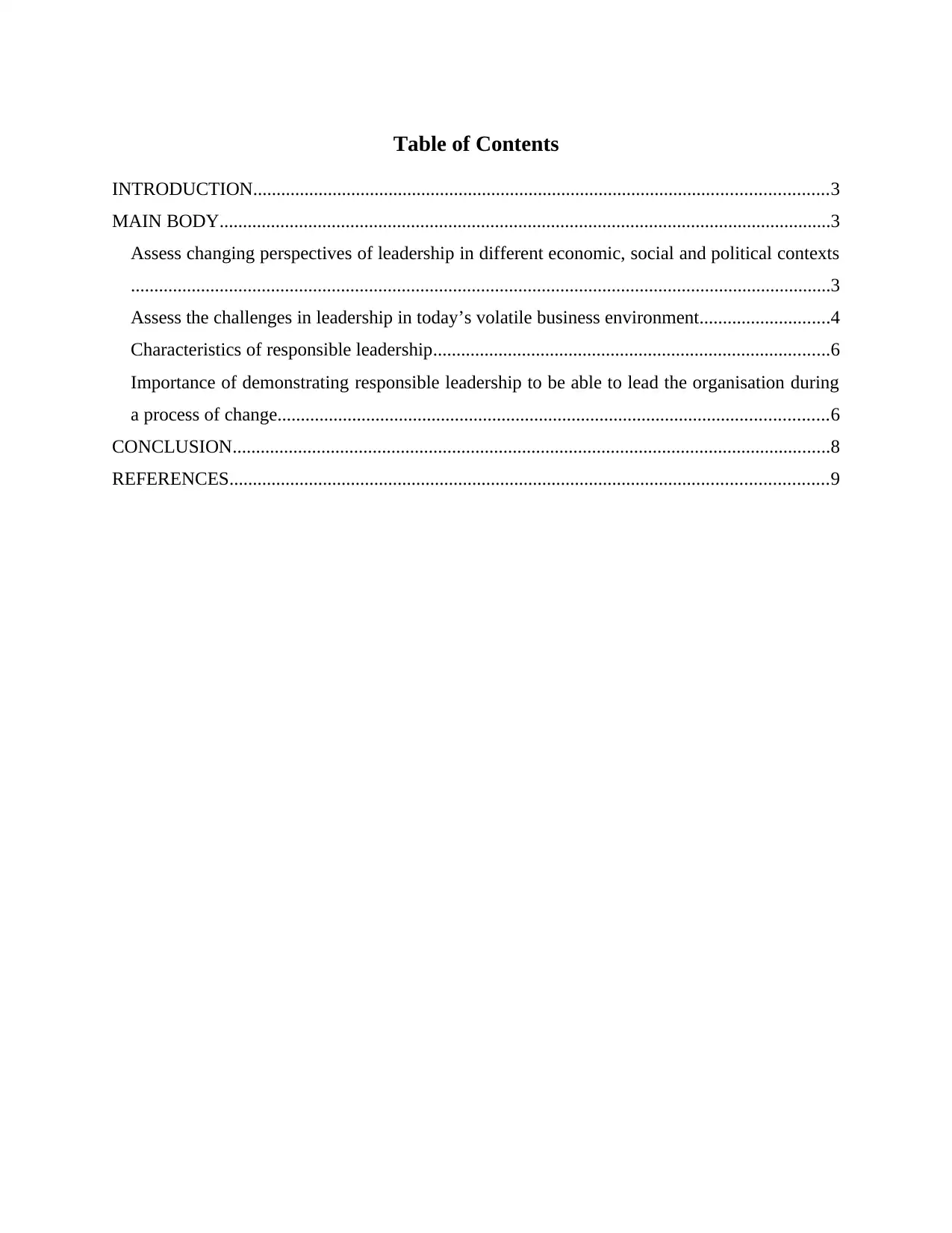
Table of Contents
INTRODUCTION...........................................................................................................................3
MAIN BODY...................................................................................................................................3
Assess changing perspectives of leadership in different economic, social and political contexts
......................................................................................................................................................3
Assess the challenges in leadership in today’s volatile business environment............................4
Characteristics of responsible leadership.....................................................................................6
Importance of demonstrating responsible leadership to be able to lead the organisation during
a process of change......................................................................................................................6
CONCLUSION................................................................................................................................8
REFERENCES................................................................................................................................9
INTRODUCTION...........................................................................................................................3
MAIN BODY...................................................................................................................................3
Assess changing perspectives of leadership in different economic, social and political contexts
......................................................................................................................................................3
Assess the challenges in leadership in today’s volatile business environment............................4
Characteristics of responsible leadership.....................................................................................6
Importance of demonstrating responsible leadership to be able to lead the organisation during
a process of change......................................................................................................................6
CONCLUSION................................................................................................................................8
REFERENCES................................................................................................................................9
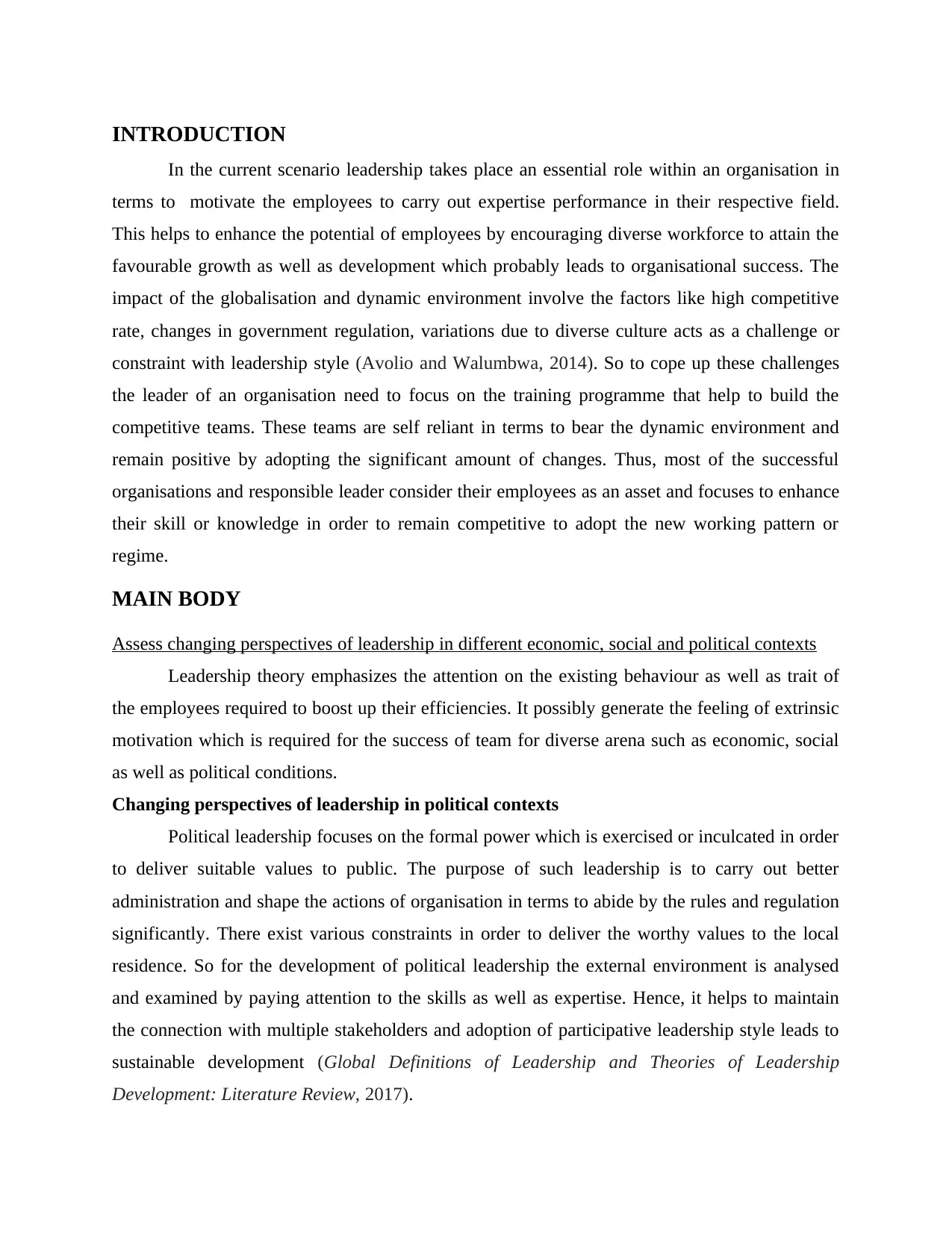
INTRODUCTION
In the current scenario leadership takes place an essential role within an organisation in
terms to motivate the employees to carry out expertise performance in their respective field.
This helps to enhance the potential of employees by encouraging diverse workforce to attain the
favourable growth as well as development which probably leads to organisational success. The
impact of the globalisation and dynamic environment involve the factors like high competitive
rate, changes in government regulation, variations due to diverse culture acts as a challenge or
constraint with leadership style (Avolio and Walumbwa, 2014). So to cope up these challenges
the leader of an organisation need to focus on the training programme that help to build the
competitive teams. These teams are self reliant in terms to bear the dynamic environment and
remain positive by adopting the significant amount of changes. Thus, most of the successful
organisations and responsible leader consider their employees as an asset and focuses to enhance
their skill or knowledge in order to remain competitive to adopt the new working pattern or
regime.
MAIN BODY
Assess changing perspectives of leadership in different economic, social and political contexts
Leadership theory emphasizes the attention on the existing behaviour as well as trait of
the employees required to boost up their efficiencies. It possibly generate the feeling of extrinsic
motivation which is required for the success of team for diverse arena such as economic, social
as well as political conditions.
Changing perspectives of leadership in political contexts
Political leadership focuses on the formal power which is exercised or inculcated in order
to deliver suitable values to public. The purpose of such leadership is to carry out better
administration and shape the actions of organisation in terms to abide by the rules and regulation
significantly. There exist various constraints in order to deliver the worthy values to the local
residence. So for the development of political leadership the external environment is analysed
and examined by paying attention to the skills as well as expertise. Hence, it helps to maintain
the connection with multiple stakeholders and adoption of participative leadership style leads to
sustainable development (Global Definitions of Leadership and Theories of Leadership
Development: Literature Review, 2017).
In the current scenario leadership takes place an essential role within an organisation in
terms to motivate the employees to carry out expertise performance in their respective field.
This helps to enhance the potential of employees by encouraging diverse workforce to attain the
favourable growth as well as development which probably leads to organisational success. The
impact of the globalisation and dynamic environment involve the factors like high competitive
rate, changes in government regulation, variations due to diverse culture acts as a challenge or
constraint with leadership style (Avolio and Walumbwa, 2014). So to cope up these challenges
the leader of an organisation need to focus on the training programme that help to build the
competitive teams. These teams are self reliant in terms to bear the dynamic environment and
remain positive by adopting the significant amount of changes. Thus, most of the successful
organisations and responsible leader consider their employees as an asset and focuses to enhance
their skill or knowledge in order to remain competitive to adopt the new working pattern or
regime.
MAIN BODY
Assess changing perspectives of leadership in different economic, social and political contexts
Leadership theory emphasizes the attention on the existing behaviour as well as trait of
the employees required to boost up their efficiencies. It possibly generate the feeling of extrinsic
motivation which is required for the success of team for diverse arena such as economic, social
as well as political conditions.
Changing perspectives of leadership in political contexts
Political leadership focuses on the formal power which is exercised or inculcated in order
to deliver suitable values to public. The purpose of such leadership is to carry out better
administration and shape the actions of organisation in terms to abide by the rules and regulation
significantly. There exist various constraints in order to deliver the worthy values to the local
residence. So for the development of political leadership the external environment is analysed
and examined by paying attention to the skills as well as expertise. Hence, it helps to maintain
the connection with multiple stakeholders and adoption of participative leadership style leads to
sustainable development (Global Definitions of Leadership and Theories of Leadership
Development: Literature Review, 2017).
⊘ This is a preview!⊘
Do you want full access?
Subscribe today to unlock all pages.

Trusted by 1+ million students worldwide
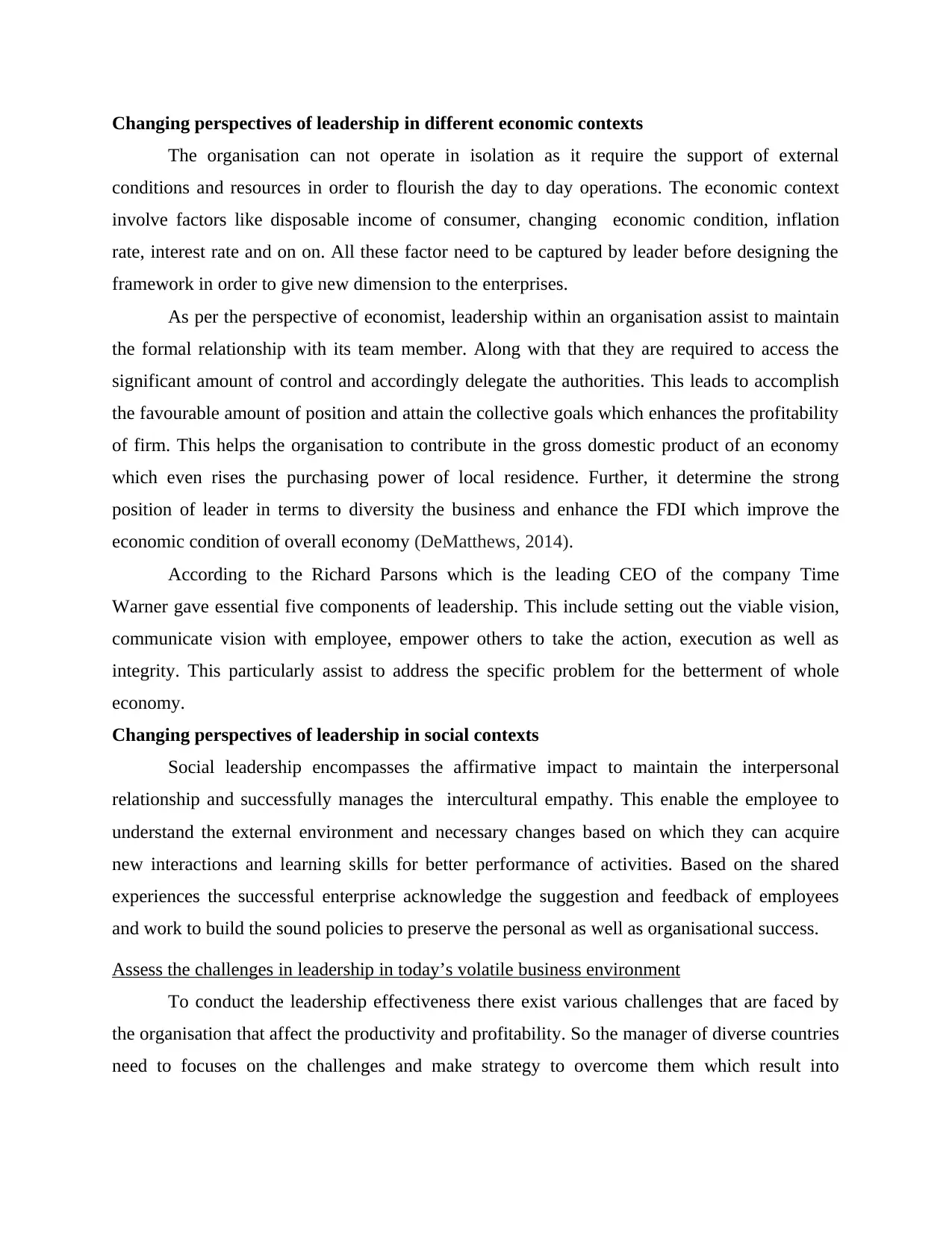
Changing perspectives of leadership in different economic contexts
The organisation can not operate in isolation as it require the support of external
conditions and resources in order to flourish the day to day operations. The economic context
involve factors like disposable income of consumer, changing economic condition, inflation
rate, interest rate and on on. All these factor need to be captured by leader before designing the
framework in order to give new dimension to the enterprises.
As per the perspective of economist, leadership within an organisation assist to maintain
the formal relationship with its team member. Along with that they are required to access the
significant amount of control and accordingly delegate the authorities. This leads to accomplish
the favourable amount of position and attain the collective goals which enhances the profitability
of firm. This helps the organisation to contribute in the gross domestic product of an economy
which even rises the purchasing power of local residence. Further, it determine the strong
position of leader in terms to diversity the business and enhance the FDI which improve the
economic condition of overall economy (DeMatthews, 2014).
According to the Richard Parsons which is the leading CEO of the company Time
Warner gave essential five components of leadership. This include setting out the viable vision,
communicate vision with employee, empower others to take the action, execution as well as
integrity. This particularly assist to address the specific problem for the betterment of whole
economy.
Changing perspectives of leadership in social contexts
Social leadership encompasses the affirmative impact to maintain the interpersonal
relationship and successfully manages the intercultural empathy. This enable the employee to
understand the external environment and necessary changes based on which they can acquire
new interactions and learning skills for better performance of activities. Based on the shared
experiences the successful enterprise acknowledge the suggestion and feedback of employees
and work to build the sound policies to preserve the personal as well as organisational success.
Assess the challenges in leadership in today’s volatile business environment
To conduct the leadership effectiveness there exist various challenges that are faced by
the organisation that affect the productivity and profitability. So the manager of diverse countries
need to focuses on the challenges and make strategy to overcome them which result into
The organisation can not operate in isolation as it require the support of external
conditions and resources in order to flourish the day to day operations. The economic context
involve factors like disposable income of consumer, changing economic condition, inflation
rate, interest rate and on on. All these factor need to be captured by leader before designing the
framework in order to give new dimension to the enterprises.
As per the perspective of economist, leadership within an organisation assist to maintain
the formal relationship with its team member. Along with that they are required to access the
significant amount of control and accordingly delegate the authorities. This leads to accomplish
the favourable amount of position and attain the collective goals which enhances the profitability
of firm. This helps the organisation to contribute in the gross domestic product of an economy
which even rises the purchasing power of local residence. Further, it determine the strong
position of leader in terms to diversity the business and enhance the FDI which improve the
economic condition of overall economy (DeMatthews, 2014).
According to the Richard Parsons which is the leading CEO of the company Time
Warner gave essential five components of leadership. This include setting out the viable vision,
communicate vision with employee, empower others to take the action, execution as well as
integrity. This particularly assist to address the specific problem for the betterment of whole
economy.
Changing perspectives of leadership in social contexts
Social leadership encompasses the affirmative impact to maintain the interpersonal
relationship and successfully manages the intercultural empathy. This enable the employee to
understand the external environment and necessary changes based on which they can acquire
new interactions and learning skills for better performance of activities. Based on the shared
experiences the successful enterprise acknowledge the suggestion and feedback of employees
and work to build the sound policies to preserve the personal as well as organisational success.
Assess the challenges in leadership in today’s volatile business environment
To conduct the leadership effectiveness there exist various challenges that are faced by
the organisation that affect the productivity and profitability. So the manager of diverse countries
need to focuses on the challenges and make strategy to overcome them which result into
Paraphrase This Document
Need a fresh take? Get an instant paraphrase of this document with our AI Paraphraser
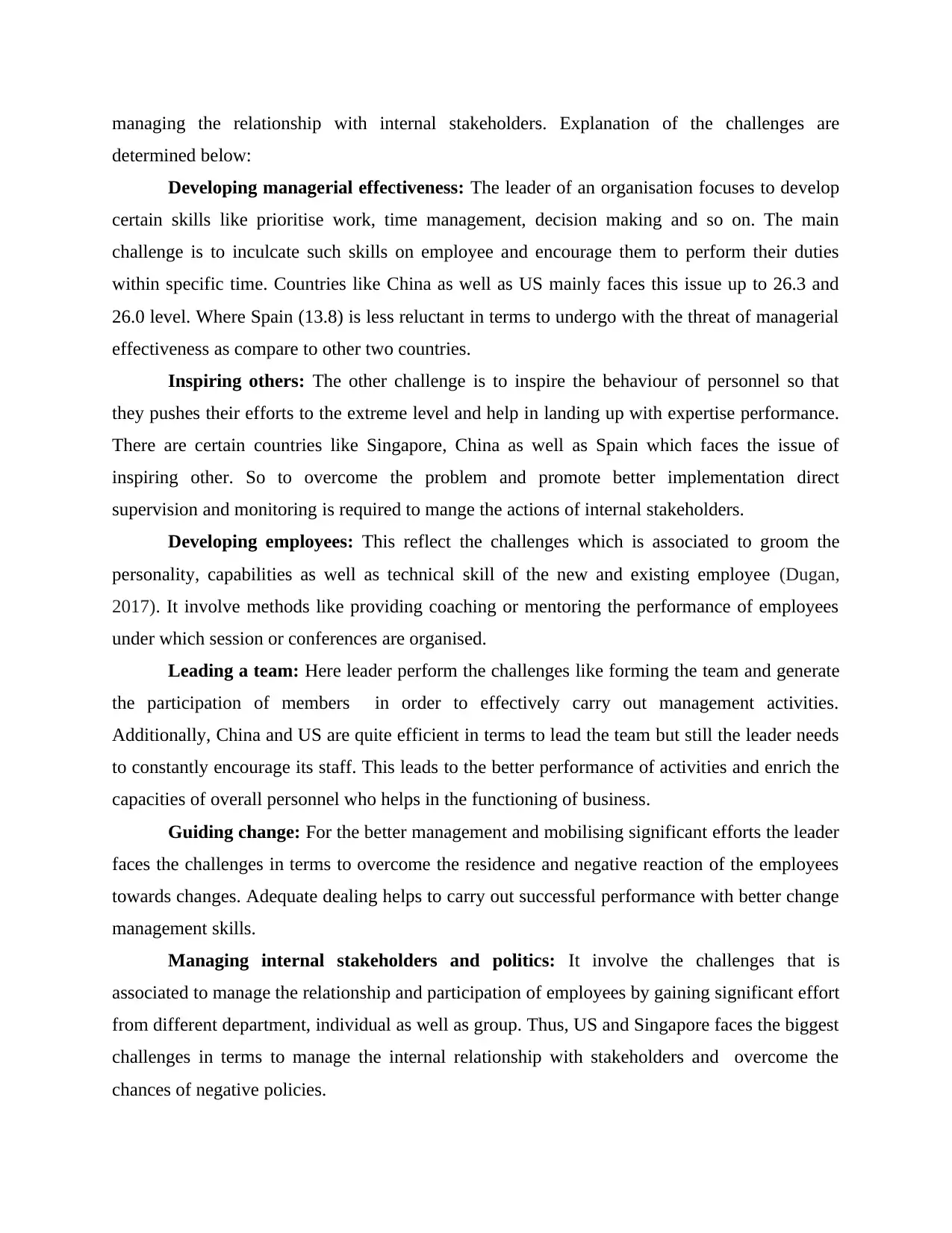
managing the relationship with internal stakeholders. Explanation of the challenges are
determined below:
Developing managerial effectiveness: The leader of an organisation focuses to develop
certain skills like prioritise work, time management, decision making and so on. The main
challenge is to inculcate such skills on employee and encourage them to perform their duties
within specific time. Countries like China as well as US mainly faces this issue up to 26.3 and
26.0 level. Where Spain (13.8) is less reluctant in terms to undergo with the threat of managerial
effectiveness as compare to other two countries.
Inspiring others: The other challenge is to inspire the behaviour of personnel so that
they pushes their efforts to the extreme level and help in landing up with expertise performance.
There are certain countries like Singapore, China as well as Spain which faces the issue of
inspiring other. So to overcome the problem and promote better implementation direct
supervision and monitoring is required to mange the actions of internal stakeholders.
Developing employees: This reflect the challenges which is associated to groom the
personality, capabilities as well as technical skill of the new and existing employee (Dugan,
2017). It involve methods like providing coaching or mentoring the performance of employees
under which session or conferences are organised.
Leading a team: Here leader perform the challenges like forming the team and generate
the participation of members in order to effectively carry out management activities.
Additionally, China and US are quite efficient in terms to lead the team but still the leader needs
to constantly encourage its staff. This leads to the better performance of activities and enrich the
capacities of overall personnel who helps in the functioning of business.
Guiding change: For the better management and mobilising significant efforts the leader
faces the challenges in terms to overcome the residence and negative reaction of the employees
towards changes. Adequate dealing helps to carry out successful performance with better change
management skills.
Managing internal stakeholders and politics: It involve the challenges that is
associated to manage the relationship and participation of employees by gaining significant effort
from different department, individual as well as group. Thus, US and Singapore faces the biggest
challenges in terms to manage the internal relationship with stakeholders and overcome the
chances of negative policies.
determined below:
Developing managerial effectiveness: The leader of an organisation focuses to develop
certain skills like prioritise work, time management, decision making and so on. The main
challenge is to inculcate such skills on employee and encourage them to perform their duties
within specific time. Countries like China as well as US mainly faces this issue up to 26.3 and
26.0 level. Where Spain (13.8) is less reluctant in terms to undergo with the threat of managerial
effectiveness as compare to other two countries.
Inspiring others: The other challenge is to inspire the behaviour of personnel so that
they pushes their efforts to the extreme level and help in landing up with expertise performance.
There are certain countries like Singapore, China as well as Spain which faces the issue of
inspiring other. So to overcome the problem and promote better implementation direct
supervision and monitoring is required to mange the actions of internal stakeholders.
Developing employees: This reflect the challenges which is associated to groom the
personality, capabilities as well as technical skill of the new and existing employee (Dugan,
2017). It involve methods like providing coaching or mentoring the performance of employees
under which session or conferences are organised.
Leading a team: Here leader perform the challenges like forming the team and generate
the participation of members in order to effectively carry out management activities.
Additionally, China and US are quite efficient in terms to lead the team but still the leader needs
to constantly encourage its staff. This leads to the better performance of activities and enrich the
capacities of overall personnel who helps in the functioning of business.
Guiding change: For the better management and mobilising significant efforts the leader
faces the challenges in terms to overcome the residence and negative reaction of the employees
towards changes. Adequate dealing helps to carry out successful performance with better change
management skills.
Managing internal stakeholders and politics: It involve the challenges that is
associated to manage the relationship and participation of employees by gaining significant effort
from different department, individual as well as group. Thus, US and Singapore faces the biggest
challenges in terms to manage the internal relationship with stakeholders and overcome the
chances of negative policies.
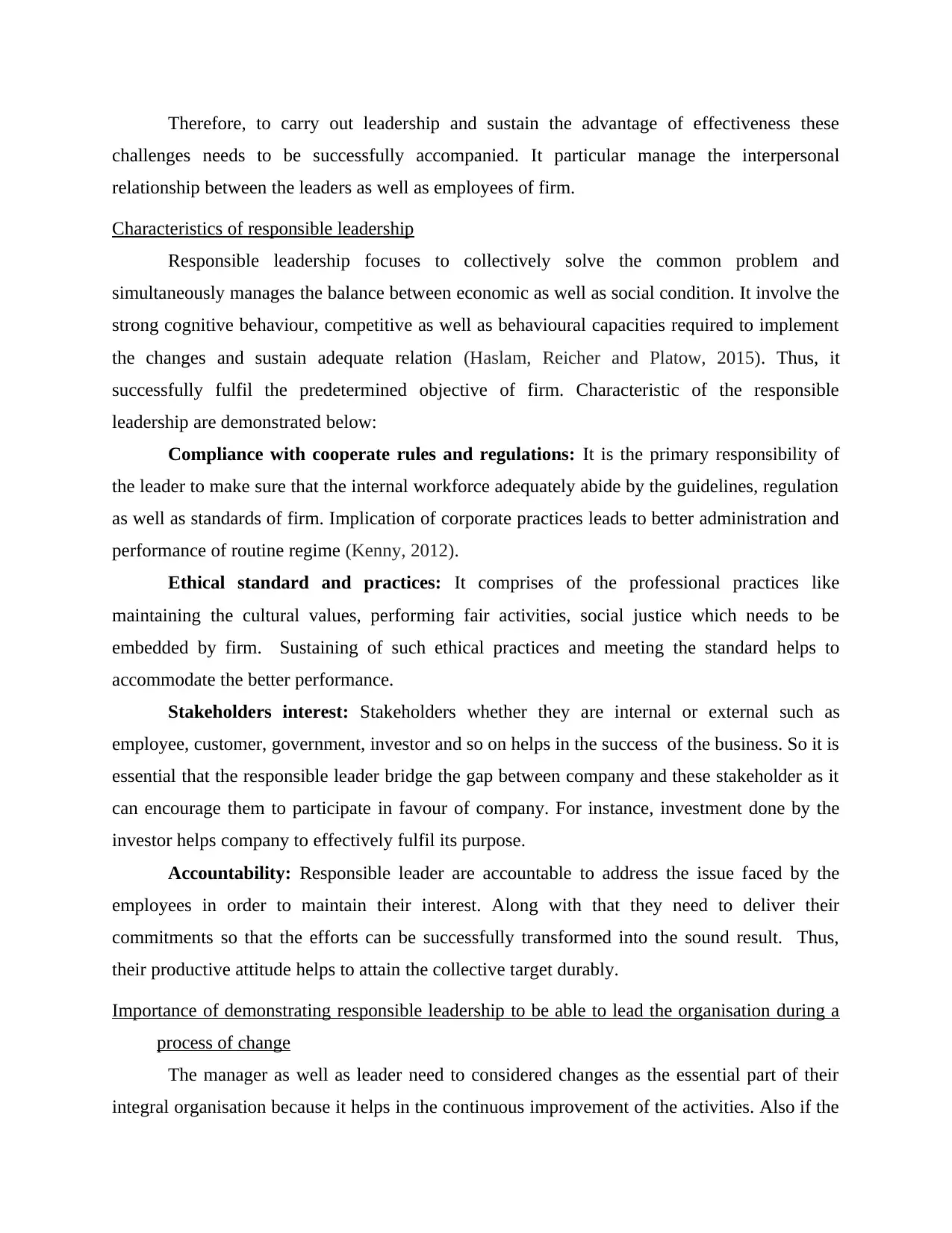
Therefore, to carry out leadership and sustain the advantage of effectiveness these
challenges needs to be successfully accompanied. It particular manage the interpersonal
relationship between the leaders as well as employees of firm.
Characteristics of responsible leadership
Responsible leadership focuses to collectively solve the common problem and
simultaneously manages the balance between economic as well as social condition. It involve the
strong cognitive behaviour, competitive as well as behavioural capacities required to implement
the changes and sustain adequate relation (Haslam, Reicher and Platow, 2015). Thus, it
successfully fulfil the predetermined objective of firm. Characteristic of the responsible
leadership are demonstrated below:
Compliance with cooperate rules and regulations: It is the primary responsibility of
the leader to make sure that the internal workforce adequately abide by the guidelines, regulation
as well as standards of firm. Implication of corporate practices leads to better administration and
performance of routine regime (Kenny, 2012).
Ethical standard and practices: It comprises of the professional practices like
maintaining the cultural values, performing fair activities, social justice which needs to be
embedded by firm. Sustaining of such ethical practices and meeting the standard helps to
accommodate the better performance.
Stakeholders interest: Stakeholders whether they are internal or external such as
employee, customer, government, investor and so on helps in the success of the business. So it is
essential that the responsible leader bridge the gap between company and these stakeholder as it
can encourage them to participate in favour of company. For instance, investment done by the
investor helps company to effectively fulfil its purpose.
Accountability: Responsible leader are accountable to address the issue faced by the
employees in order to maintain their interest. Along with that they need to deliver their
commitments so that the efforts can be successfully transformed into the sound result. Thus,
their productive attitude helps to attain the collective target durably.
Importance of demonstrating responsible leadership to be able to lead the organisation during a
process of change
The manager as well as leader need to considered changes as the essential part of their
integral organisation because it helps in the continuous improvement of the activities. Also if the
challenges needs to be successfully accompanied. It particular manage the interpersonal
relationship between the leaders as well as employees of firm.
Characteristics of responsible leadership
Responsible leadership focuses to collectively solve the common problem and
simultaneously manages the balance between economic as well as social condition. It involve the
strong cognitive behaviour, competitive as well as behavioural capacities required to implement
the changes and sustain adequate relation (Haslam, Reicher and Platow, 2015). Thus, it
successfully fulfil the predetermined objective of firm. Characteristic of the responsible
leadership are demonstrated below:
Compliance with cooperate rules and regulations: It is the primary responsibility of
the leader to make sure that the internal workforce adequately abide by the guidelines, regulation
as well as standards of firm. Implication of corporate practices leads to better administration and
performance of routine regime (Kenny, 2012).
Ethical standard and practices: It comprises of the professional practices like
maintaining the cultural values, performing fair activities, social justice which needs to be
embedded by firm. Sustaining of such ethical practices and meeting the standard helps to
accommodate the better performance.
Stakeholders interest: Stakeholders whether they are internal or external such as
employee, customer, government, investor and so on helps in the success of the business. So it is
essential that the responsible leader bridge the gap between company and these stakeholder as it
can encourage them to participate in favour of company. For instance, investment done by the
investor helps company to effectively fulfil its purpose.
Accountability: Responsible leader are accountable to address the issue faced by the
employees in order to maintain their interest. Along with that they need to deliver their
commitments so that the efforts can be successfully transformed into the sound result. Thus,
their productive attitude helps to attain the collective target durably.
Importance of demonstrating responsible leadership to be able to lead the organisation during a
process of change
The manager as well as leader need to considered changes as the essential part of their
integral organisation because it helps in the continuous improvement of the activities. Also if the
⊘ This is a preview!⊘
Do you want full access?
Subscribe today to unlock all pages.

Trusted by 1+ million students worldwide
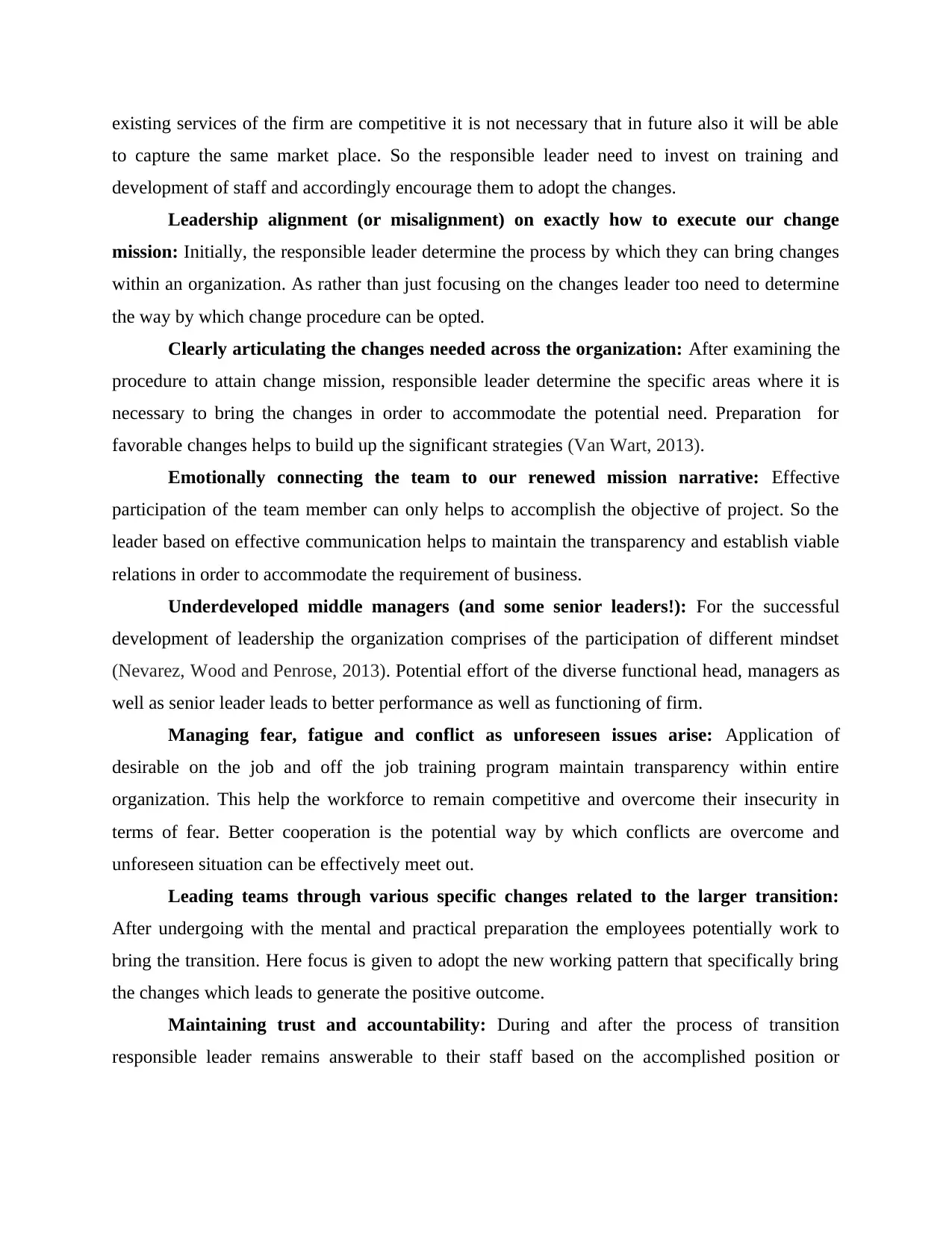
existing services of the firm are competitive it is not necessary that in future also it will be able
to capture the same market place. So the responsible leader need to invest on training and
development of staff and accordingly encourage them to adopt the changes.
Leadership alignment (or misalignment) on exactly how to execute our change
mission: Initially, the responsible leader determine the process by which they can bring changes
within an organization. As rather than just focusing on the changes leader too need to determine
the way by which change procedure can be opted.
Clearly articulating the changes needed across the organization: After examining the
procedure to attain change mission, responsible leader determine the specific areas where it is
necessary to bring the changes in order to accommodate the potential need. Preparation for
favorable changes helps to build up the significant strategies (Van Wart, 2013).
Emotionally connecting the team to our renewed mission narrative: Effective
participation of the team member can only helps to accomplish the objective of project. So the
leader based on effective communication helps to maintain the transparency and establish viable
relations in order to accommodate the requirement of business.
Underdeveloped middle managers (and some senior leaders!): For the successful
development of leadership the organization comprises of the participation of different mindset
(Nevarez, Wood and Penrose, 2013). Potential effort of the diverse functional head, managers as
well as senior leader leads to better performance as well as functioning of firm.
Managing fear, fatigue and conflict as unforeseen issues arise: Application of
desirable on the job and off the job training program maintain transparency within entire
organization. This help the workforce to remain competitive and overcome their insecurity in
terms of fear. Better cooperation is the potential way by which conflicts are overcome and
unforeseen situation can be effectively meet out.
Leading teams through various specific changes related to the larger transition:
After undergoing with the mental and practical preparation the employees potentially work to
bring the transition. Here focus is given to adopt the new working pattern that specifically bring
the changes which leads to generate the positive outcome.
Maintaining trust and accountability: During and after the process of transition
responsible leader remains answerable to their staff based on the accomplished position or
to capture the same market place. So the responsible leader need to invest on training and
development of staff and accordingly encourage them to adopt the changes.
Leadership alignment (or misalignment) on exactly how to execute our change
mission: Initially, the responsible leader determine the process by which they can bring changes
within an organization. As rather than just focusing on the changes leader too need to determine
the way by which change procedure can be opted.
Clearly articulating the changes needed across the organization: After examining the
procedure to attain change mission, responsible leader determine the specific areas where it is
necessary to bring the changes in order to accommodate the potential need. Preparation for
favorable changes helps to build up the significant strategies (Van Wart, 2013).
Emotionally connecting the team to our renewed mission narrative: Effective
participation of the team member can only helps to accomplish the objective of project. So the
leader based on effective communication helps to maintain the transparency and establish viable
relations in order to accommodate the requirement of business.
Underdeveloped middle managers (and some senior leaders!): For the successful
development of leadership the organization comprises of the participation of different mindset
(Nevarez, Wood and Penrose, 2013). Potential effort of the diverse functional head, managers as
well as senior leader leads to better performance as well as functioning of firm.
Managing fear, fatigue and conflict as unforeseen issues arise: Application of
desirable on the job and off the job training program maintain transparency within entire
organization. This help the workforce to remain competitive and overcome their insecurity in
terms of fear. Better cooperation is the potential way by which conflicts are overcome and
unforeseen situation can be effectively meet out.
Leading teams through various specific changes related to the larger transition:
After undergoing with the mental and practical preparation the employees potentially work to
bring the transition. Here focus is given to adopt the new working pattern that specifically bring
the changes which leads to generate the positive outcome.
Maintaining trust and accountability: During and after the process of transition
responsible leader remains answerable to their staff based on the accomplished position or
Paraphrase This Document
Need a fresh take? Get an instant paraphrase of this document with our AI Paraphraser
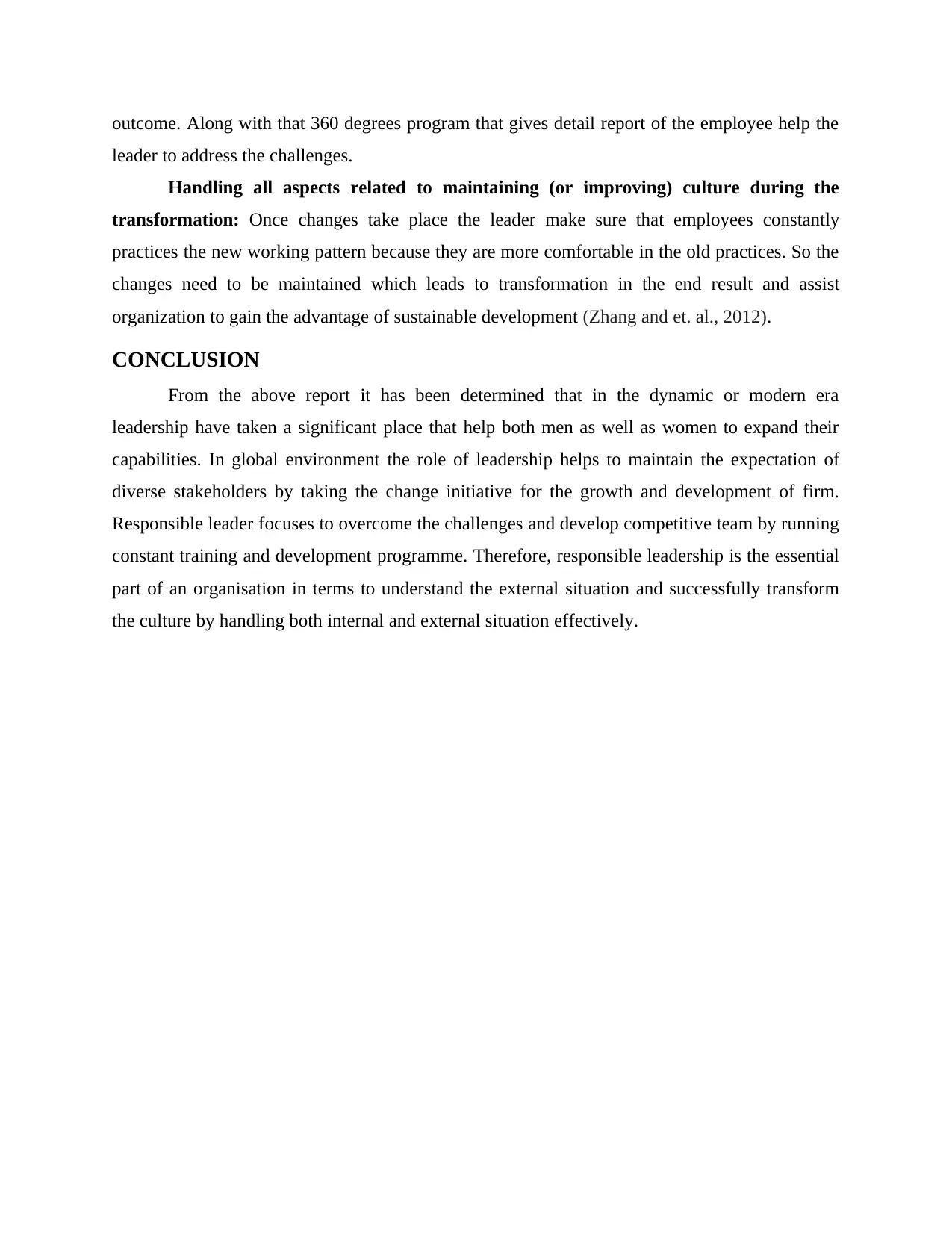
outcome. Along with that 360 degrees program that gives detail report of the employee help the
leader to address the challenges.
Handling all aspects related to maintaining (or improving) culture during the
transformation: Once changes take place the leader make sure that employees constantly
practices the new working pattern because they are more comfortable in the old practices. So the
changes need to be maintained which leads to transformation in the end result and assist
organization to gain the advantage of sustainable development (Zhang and et. al., 2012).
CONCLUSION
From the above report it has been determined that in the dynamic or modern era
leadership have taken a significant place that help both men as well as women to expand their
capabilities. In global environment the role of leadership helps to maintain the expectation of
diverse stakeholders by taking the change initiative for the growth and development of firm.
Responsible leader focuses to overcome the challenges and develop competitive team by running
constant training and development programme. Therefore, responsible leadership is the essential
part of an organisation in terms to understand the external situation and successfully transform
the culture by handling both internal and external situation effectively.
leader to address the challenges.
Handling all aspects related to maintaining (or improving) culture during the
transformation: Once changes take place the leader make sure that employees constantly
practices the new working pattern because they are more comfortable in the old practices. So the
changes need to be maintained which leads to transformation in the end result and assist
organization to gain the advantage of sustainable development (Zhang and et. al., 2012).
CONCLUSION
From the above report it has been determined that in the dynamic or modern era
leadership have taken a significant place that help both men as well as women to expand their
capabilities. In global environment the role of leadership helps to maintain the expectation of
diverse stakeholders by taking the change initiative for the growth and development of firm.
Responsible leader focuses to overcome the challenges and develop competitive team by running
constant training and development programme. Therefore, responsible leadership is the essential
part of an organisation in terms to understand the external situation and successfully transform
the culture by handling both internal and external situation effectively.
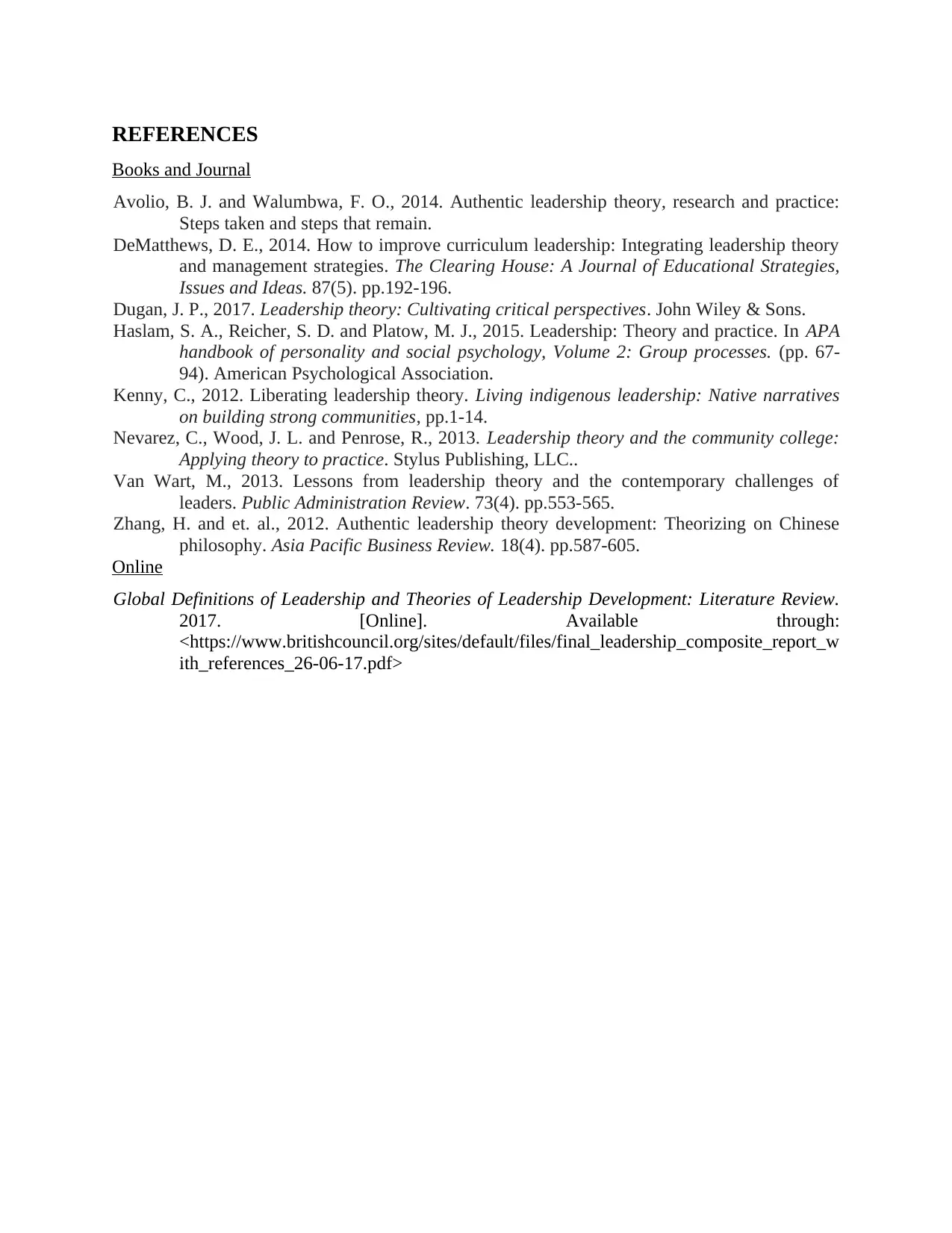
REFERENCES
Books and Journal
Avolio, B. J. and Walumbwa, F. O., 2014. Authentic leadership theory, research and practice:
Steps taken and steps that remain.
DeMatthews, D. E., 2014. How to improve curriculum leadership: Integrating leadership theory
and management strategies. The Clearing House: A Journal of Educational Strategies,
Issues and Ideas. 87(5). pp.192-196.
Dugan, J. P., 2017. Leadership theory: Cultivating critical perspectives. John Wiley & Sons.
Haslam, S. A., Reicher, S. D. and Platow, M. J., 2015. Leadership: Theory and practice. In APA
handbook of personality and social psychology, Volume 2: Group processes. (pp. 67-
94). American Psychological Association.
Kenny, C., 2012. Liberating leadership theory. Living indigenous leadership: Native narratives
on building strong communities, pp.1-14.
Nevarez, C., Wood, J. L. and Penrose, R., 2013. Leadership theory and the community college:
Applying theory to practice. Stylus Publishing, LLC..
Van Wart, M., 2013. Lessons from leadership theory and the contemporary challenges of
leaders. Public Administration Review. 73(4). pp.553-565.
Zhang, H. and et. al., 2012. Authentic leadership theory development: Theorizing on Chinese
philosophy. Asia Pacific Business Review. 18(4). pp.587-605.
Online
Global Definitions of Leadership and Theories of Leadership Development: Literature Review.
2017. [Online]. Available through:
<https://www.britishcouncil.org/sites/default/files/final_leadership_composite_report_w
ith_references_26-06-17.pdf>
Books and Journal
Avolio, B. J. and Walumbwa, F. O., 2014. Authentic leadership theory, research and practice:
Steps taken and steps that remain.
DeMatthews, D. E., 2014. How to improve curriculum leadership: Integrating leadership theory
and management strategies. The Clearing House: A Journal of Educational Strategies,
Issues and Ideas. 87(5). pp.192-196.
Dugan, J. P., 2017. Leadership theory: Cultivating critical perspectives. John Wiley & Sons.
Haslam, S. A., Reicher, S. D. and Platow, M. J., 2015. Leadership: Theory and practice. In APA
handbook of personality and social psychology, Volume 2: Group processes. (pp. 67-
94). American Psychological Association.
Kenny, C., 2012. Liberating leadership theory. Living indigenous leadership: Native narratives
on building strong communities, pp.1-14.
Nevarez, C., Wood, J. L. and Penrose, R., 2013. Leadership theory and the community college:
Applying theory to practice. Stylus Publishing, LLC..
Van Wart, M., 2013. Lessons from leadership theory and the contemporary challenges of
leaders. Public Administration Review. 73(4). pp.553-565.
Zhang, H. and et. al., 2012. Authentic leadership theory development: Theorizing on Chinese
philosophy. Asia Pacific Business Review. 18(4). pp.587-605.
Online
Global Definitions of Leadership and Theories of Leadership Development: Literature Review.
2017. [Online]. Available through:
<https://www.britishcouncil.org/sites/default/files/final_leadership_composite_report_w
ith_references_26-06-17.pdf>
⊘ This is a preview!⊘
Do you want full access?
Subscribe today to unlock all pages.

Trusted by 1+ million students worldwide
1 out of 9
Related Documents
Your All-in-One AI-Powered Toolkit for Academic Success.
+13062052269
info@desklib.com
Available 24*7 on WhatsApp / Email
![[object Object]](/_next/static/media/star-bottom.7253800d.svg)
Unlock your academic potential
Copyright © 2020–2025 A2Z Services. All Rights Reserved. Developed and managed by ZUCOL.





